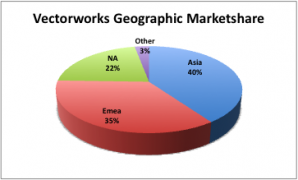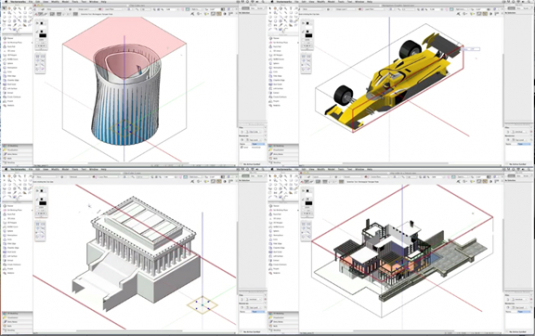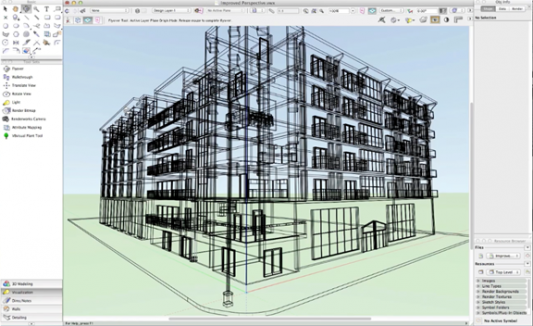Other new features include new 3D editing tools and enhancements to architectural presentations.
Nemetschek Vectorworks, Inc. has announced significant upgrades to its line of products, which includes Vectorworks Designer, Architect, Landmark, Spotlight, Fundamentals, and Renderworks. In their demos and presentations of the new product line the company emphasizes the importance of BIM, presentations, and performance.
In North America Vectorworks sometimes gets lost in the shadows of Autodesk, but it has a loyal international user base and for a long time, it enjoyed the status of being one of the most capable CAD programs on the Mac platform along with Graphisoft, another Nemetschek product. Vectorworks products are much more widely used in Europe and Asia where BIM is increasingly being used; Asia now accounts for more than 40% of Vectorworks revenues.

Previous to this update the company released Vectorworks Cloud Services to Service Select subscription customers. Cloud Services gives customers the options of storing work in the cloud so that it can be accessed wherever they are and using a variety of devices. The company has released Nomad app for iOS which enables users to view, mark up, save, print, and share designs. Vectorworks says an Android version is coming out in the shortly. But, Vectorworks has much bigger visions for the cloud with the announcement of the 2013 release; Vectorworks CEO Sean Flaherty said the company will be expanding applications for the cloud.
Saying that he doesn’t see the whole design process moving to the cloud, Flaherty says he believes that there are always some functions that are best done on the client. But he doesn’t totally rule it out either. For Vectorworks 2013 and the future Flaherty says more capabilities are moving to the cloud. Moving beyond sharing files and data or creating presentations, the calculations for functions such as generating sections, elevations, and renderings are moving to the cloud.
The Vectorworks 2013 line of products has seen many feature updates, but the company is focusing on three major areas, performance improvement, new cloud features, enhanced interoperability including support for major CAD formats, and BIM improvements. Also, Vectorworks has optimized its tools for the theater and entertainment industries to capitalize on the product’s strength in that market segment.
In 2009, the company revamped Vectorworks by switching to Parasolid modeler as its 3D kernel, replacing Solids++. With Vectorworks 2013, the product had a new clip feature that lets customers work with a clip cube area to isolate geometry within the cube and even edit it. The advantages of the Parasolid modeler are also on display in the improvements made to roofing tools.

New modeling tools include the Surface Array command, which enables users to create complex NURBS-based surfaces by creating an array of 2D and 3D geometry. The technique will be useful for roof surfaces, curtain walls, and stadium structures. Vectorworks also has an improved perspective projection mode with a configurable horizon.
This release is heavy on BIM with new organizational features that make easier to find and access information, interoperability with other CAD programs, and support OpenBIM. The program now enables import and export of IFC, DWG/DXF, and ODBC, as well as support for Rhino 3DM, DWF, FBX, COLLADA, and gbXML. Improved interoperability is a major request from users says Vectorworks VP of development Biplab Sarkar.
New advances in rendering include non-blocking rendering. This feature allows people to continue to work on a design while it updates rendering information in the background. The Vectorworks modeler maintains 2D information in the background to make switching between contexts easier. The 2013 version will also include textures from Arroway and fast access from the menu to buy more Arroway textures. The new, built-in library includes wood veneers, concrete, wood flooring, stonework, tiles and other construction materials.

The new Vectorworks is getting hardware support from graphics processors but Sarkar says the company did not use tools such as Nvidia’s CUDA but rather did it themselves using techniques similar to those provided by Nvidia or AMD. Vectorworks takes advantage of OpenGL for its graphics performance and Sarkar says they’re putting a lot of the model in memory to get performance improvements.
Overall, Vectorworks says it has improved the performance of its 3D tools, it has improved the interoperability between 2D and 3D, and it has made significant improvements in its use of Maxon’s rendering engine, Cinema4D, another Nemetschek product.
For its theater and entertainment design customers Vectorworks has added interactive tools for lighting and audio fixtures.
Our take
The Vectorworks people work really hard and keep their heads down. They’re not the most talkative of companies we work with. When they do talk, they usually have something to say. This is a significant release and we were impressed with the advanced capabilities. One of the biggest complaints we’ve heard from the user community is around ease of use. The company is addressing these issues, but it’s obviously still got a lot of functionality it wants to enable as well.
Also notable is the advantage the company is getting from the Parasolid modeler. It’s giving Vectorworks the kinds of capabilities that are exciting architects looking for more free-form design using NURBS-based tools.
Related
Nemetschek and CABR to work on BIM standards for China
New SimTread for Vectorworks simulates crowd movement





